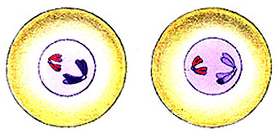

Telophase II: chromosomes decondense, nuclear membrane and nucleolus forms, centrioles move back together.Anaphase II: paired chromatids separate and are pulled to alternate poles.Metaphase II: microtubules connect from the centrioles to the centromeres, and the paired chromatids line up along the equator of the cell.Prophase II: chromosomes condense and centrioles move to the poles.Telophase I: chromosomes decondense, nuclear membrane and nucleolus forms, centrioles move back together.Anaphase I: paired chromosomes separate and are pulled to alternate poles.Metaphase I: microtubules connect from the centrioles to the centromeres, and the paired chromosomes line up along the equator of the cell.Prophase I: chromosomes condense, undergo duplication and crossing over, and centrioles move to the poles.In diplotene and diakinesis stages, nuclear membrane disappears and spindle fibres formations begins.The pachytene is the longest stage of the meiotic prophase, during which crossing over and genetic recombination takes place between the paired homologous chromosomes.

These Synaptonemal complex have a tripartite structure, comprising a central element bounded by two lateral elements. During the zygotene stage, the parental homologous chromosomes pair with the help of a structure known as the Synaptonemal complex (SC).In leptotene stage, the chromosomes condense along their axial elements.This prophase-I is divided into five distinct stages which are termed as (a) leptotene, (b) zygotene, (c) pachytene, (d) diplotene, and (e) diakinesis.Before the onset of meiotic division, the chromosomes of the pre-gametic cell are replicated to yield two pairs of sister chromatids after which they enter a long meiotic prophase interval.The phases of meiosis is divided into two meiosis-I and meiosis-II.Meiosis consists of two rounds of chromosome segregation following a single replication.The events of meiosis of a cell includes duplication of chromosomes which is followed by one reductional division and other equational division resulting into four haploid cells, each containing half the number of chromosomes. Meiosis division occurs during gametogenesis in higher organism (eukaryotic cells).Only upon fertilization will the metaphase-II-arrested eggs exit meiosis II and enter interphase. Meiotic arrest of oogenesis: Vertebrate eggs are arrested at the metaphase stage of meiosis II. " Peter made a tart." OR " Passed my anatomy test!" OR " Perhaps my Aunt Tillie." Take your pick. Mneumonic device: You can remember the first letters of each of the stages of meiosis in order by remembering one of the following three sentences: As it is, they are neatly packed and ready for delivery to the poles! If condensation did not occur as meiosis and mitosis began, the long spaghetti-like strands of the uncondensed interphase chromosomes would become hopelessly tangled like a fisherman's knot during chromosome segregation. Chromosome condensation is carried out primarily by the condensin complex and occurs as the strands of DNA are tightly wrapped around histone molecules that act much like the reel of a fishing pole ( see picture). Mitosis happens everywhere, even in my toe,Įtymology: The name of this stage of meiosis is derived from two Greek words, meta, meaning "after," "later" or "more advanced," and phasis, meaning "stage."Ĭhromosome condensation is the reorganisation of the long thin chromatin strands, of which chromosomes are composed during interphase, into compact short masses during prophase of mitosis (as well as in prophase I of meiosis). This results in separation of the sister chromatids of each chromosome during the next phase of meiosis, anaphase II. This time, unlike metaphase I, the two kinetochores of each centromere bind to spindle fibers from opposite poles (as in mitotic metaphase). In metaphase II, the second stage of meiosis II, in each of the two daughter cells produced by the first meiotic division (which are known as secondary germ cells), the spindle again draws the chromosomes to the metaphase plate. Note: Meiosis II is very similar to mitosis.


 0 kommentar(er)
0 kommentar(er)
